1、层次索引
1.1 定义
在某一个方向拥有多个(两个及两个以上)索引级别,就叫做层次索引。
通过层次化索引,pandas能够以较低维度形式处理高纬度的数据
通过层次化索引,可以按照层次统计数据
层次索引包括series层次索引和dataframe层次索引
1.2 series的层次索引
|
1
2
3
4
5
6
|
import numpy as npimport pandas as pds1 = pd.series(data=[99, 80, 76, 80, 99], index=[['2017', '2017', '2018', '2018', '2018'], ['张伊曼', '张巧玲', '张诗诗', '张思思', '张可可']])print(s1) |
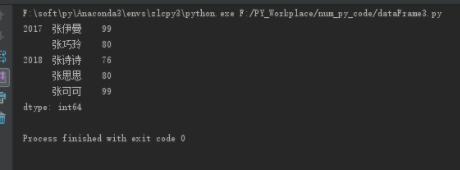
1.3 dataframe的层次索引
|
1
2
3
4
5
6
7
8
9
10
11
12
13
14
15
16
17
18
19
20
21
22
23
24
25
|
# dataframe的层次索引df1 = pd.dataframe({ 'year': [2016, 2016, 2017, 2017, 2018], 'fruit': ['apple', 'banana', 'apple', 'banana', 'apple'], 'production': [10, 30, 20, 70, 100], 'profits': [40, 30, 60, 80,10],})print("df1===================================")print(df1)df2 = df1.set_index(['year', 'fruit'])print("df2===================================")print(df2)print("df2.index===================================")print(df2.index)print("df2.sum(level='year')===================================")print(df2.sum(level='year'))print("df2.mean(level='fruit')===================================")print(df2.mean(level='fruit'))print("df2.sum(level=['year', 'fruit'])===================================")print(df2.sum(level=['year', 'fruit'])) |
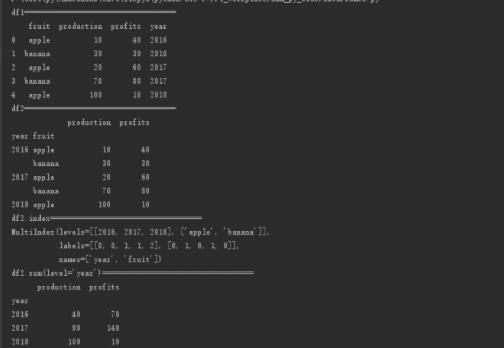
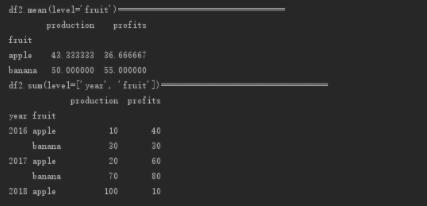
2、取值的新方法
ix是比较老的方法 新方式是使用iloc loc
iloc 对下标值进行操作 series与dataframe都可以操作
loc 对索引值进行操作 series与dataframe都可以操作
2.1 series
|
1
2
3
4
5
6
7
8
9
10
11
12
|
# # 取值的新方法s1 = pd.series(data=[99, 80, 76, 80, 99], index=[['2017', '2017', '2018', '2018', '2018'], ['张伊曼', '张巧玲', '张诗诗', '张思思', '张可可']])print("s1=================================")print(s1)print("s1.iloc[2]=================================")print(s1.iloc[2])print("s1.loc['2018']['张思思']=================================")print(s1.loc['2018']['张思思']) |
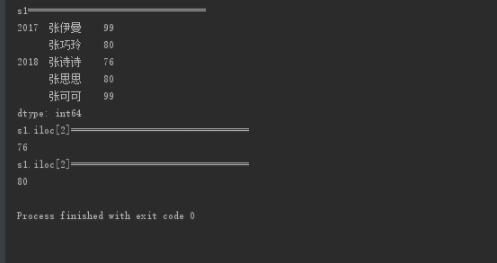
2.2 dataframe
|
1
2
3
4
5
6
7
8
9
10
11
12
13
14
15
16
17
18
19
20
21
22
|
df1 = pd.dataframe({ 'year': [2016, 2016, 2017, 2017, 2018], 'fruit': ['apple', 'banana', 'apple', 'banana', 'apple'], 'production': [10, 30, 20, 70, 100], 'profits': [40, 30, 60, 80,10],})print("df1===================================")print(df1)print("旧方法获取值===================================")print("df1['year'][0]===================================")print(df1['year'][0])print("df1.ix[0]['year']===================================")print(df1.ix[0]['year'])print("新方法获取值===================================")print("df1.iloc[0][3]===================================")print(df1.iloc[0][3])print("df1.loc[0]['year']===================================")print(df1.loc[0]['year']) |
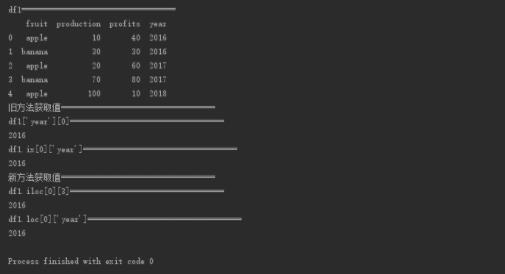
以上这篇对pandas的层次索引与取值的新方法详解就是小编分享给大家的全部内容了,希望能给大家一个参考,也希望大家多多支持服务器之家。
原文链接:https://blog.csdn.net/u010157004/article/details/79588022










